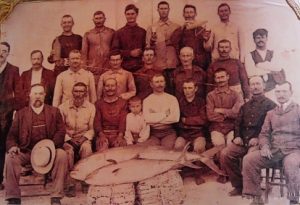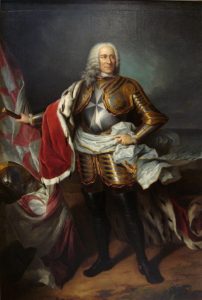
WELCOME!
to
It-Tunnara
and
Westreme Battery

Westreme Battery was built by the Order of Saint John in 1715–1716 as one of a series of coastal fortifications around the coasts of the Maltese Islands.
Most of the battery was destroyed over time, but the blockhouse still exists. It is now open to the public as the Tunnara Museum, a museum about tuna fishing.
The museum depicts the history of the Westreme battery and the mattanza – a traditional way of catching the Mediterranean bluefin tuna, used only in Malta, Sicily, and Sardinia.
The museum holds a number of original artefacts and a large display of different nets and tools used in the traditional mattanza, making it the only museum of its kind in Malta.
History
 Westreme Battery was built between 1715 and 1716 as part of the Order of Saint John’s first building program of coastal fortifications. The battery was probably named after a knight of the same name. The battery was one of two batteries guarding Mellieħa Bay, the other one being the now-demolished Fedeau Battery. The area was further defended by Mellieħa Redoubt at the centre of the bay, but this no longer exists.
Westreme Battery was built between 1715 and 1716 as part of the Order of Saint John’s first building program of coastal fortifications. The battery was probably named after a knight of the same name. The battery was one of two batteries guarding Mellieħa Bay, the other one being the now-demolished Fedeau Battery. The area was further defended by Mellieħa Redoubt at the centre of the bay, but this no longer exists.
The battery consisted of a semi-circular gun platform, with its eastern face having a parapet with five embrasures. There was no parapet around the rest of the platform. This arrangement was similar to the one at the nearby Mistra Battery, but on a larger scale. The battery also had a single blockhouse, placed diagonally along the land front so that its two outer faces functioned as a redan, similar to Saint Mary’s Battery. The blockhouse, which was pierced with musketry loopholes, was one of the largest blockhouses in any of the coastal batteries in Malta. These features put together made the battery unique, unlike any other in the Maltese islands.
It-Tunnara
In 1748, Grand Master Pinto inaugurated the Tunnara, a traditional Maltese tuna fishing method, at Westreme Battery. Over the years, the battery’s military importance was diminished, and it was used as a store for fishing nets and other equipment used in the Tunnara.
the Tunnara, a traditional Maltese tuna fishing method, at Westreme Battery. Over the years, the battery’s military importance was diminished, and it was used as a store for fishing nets and other equipment used in the Tunnara.
During the French invasion of Malta of 1798, Westreme Battery was the first battery to be overrun by the invading forces.
In World War II, the blockhouse was converted into a beach post. Rectangular machine gun portholes were cut into the corners of the building. Another concrete beach post and a searchlight emplacement were also built near the blockhouse. After the war, the blockhouse was again used in the Tunnara.

Emanuel Pinto da Fonseca (24 May 1681 – 23 January 1773) was a Portuguese nobleman, the 68th Grand Master of the Order of Saint John, from 1741 until his death.
He undertook many building projects, introducing the Baroque style throughout Malta. The cost of these projects contributed to bankrupting the Order in the decades following his death. His views were comparatively liberal. In 1764, he agreed to the re-unification with the Protestant Prussian branch of the Order, without, however, receiving the approval of Pope Clement XIII. The pope did agree, reluctantly, to the expulsion of the Jesuits from Malta in 1768.
He was the son of Miguel Álvaro Pinto da Fonseca, Alcaide-Mór de Ranhados, and his wife, Ana Pinto Teixeira. The coat of arms of the Pinto portrays five red crescents, to symbolising that the Pinto de Fonseca family won five battles with the Ottomans. Before his election as Grand Master on 18 January 1741, Pinto da Fonseca was a knight of the Langue of Portugal. He had an illegitimate son by one Rosenda Paulichi, daughter of Alberigo Paulichi and Patronilla Ramuzetta, named José António Pinto da Fonseca e Vilhena, who married his first cousin Maria Inácia Pinto da Fonseca de Sousa Teixeira e Vilhena, illegitimate daughter of Francisco Vaz Pinto (his father’s brother) by one Clara Cerqueira. He was elected as Grand Master in his 60th year, and he lived to be a nonagenarian, ruling the Order for 32 years.
As Grand Master, Pinto da Fonseca kept an elaborate court, imitating the courts of the great European princes of his era. The court was a centre of intrigue, the Grand Master being surrounded by a multitude of “ambitious pretenders”.
In 1749, one of his bodyguards, Giuseppe Cohen, refused to join a plot led by Pasha Mustafa to stage a Muslim slave revolt; this refusal led to the exposure and suppression of the revolt, which afterward was celebrated each 29 June, the anniversary.
Pinto da Fonseca made substantial donations to the Conventual Church, and among the most notable mementoes are two large and heavy bells cast by the Master Founder of the Order of Saint John, Aloisio Bouchut, in 1747 and 1748; they still hang in the belfries of what is now the Co-Cathedral. These bells were made by melting two basilisks that were left by the Ottomans after the Great Siege of 1565. As Grand Master, Pinto da Fonseca completed construction of the Auberge de Castille (still one of the most important buildings in the Maltese capital city, Valletta); his bust and arms adorn its façade. Today this building houses the Office of the Prime Minister. Pinto built nineteen storehouses at the Marina, which still bear his name, and built several other buildings and structures. In 1756, he has built the first printing press in Malta at the magistral palace of the Grand Master, known as la stamperia del Palazzo. Pinto gave his name to the then town of Qormi and accorded it the status of a city as “Città Pinto”. The city of Qormi adopted the Pinto arms, with the tinctures reversed, for its own coat of arms and flag. Pinto gained a bad reputation for creating large debts for the treasury of the Order, leading to bankruptcy.
In 1764, Pinto da Fonseca negotiated with King Frederick II (“Frederick the Great”) of Prussia a reunification of the Protestant Bailiwick of Brandenburg with the Catholic Order of Saint John, but as Pope Clement XIII would not allow admission into a Roman Catholic organization of men viewed as heretics by the Church, the agreement came to naught.
In 1765/6, Pinto was befriended by Italian adventurer and occultist Alessandro Cagliostro. A Master Mason of Freemasonry, don Pinto initiated to the 33rd degree don Raimondo di Sangro, prince of Sansevero, which later established the first Scottish Rite Masonic Lodge in Naples, Italy.
Malta since 1734 was nominally a fief under the House of Bourbon-Two Sicilies, from 1759 under Ferdinand III. Bernardo Tanucci pressured Pinto to follow the Bourbon policy of suppression of the Jesuits, threatening a boycott of Malta if he refused. Pinto consulted with Pope Clement XIII, who reluctantly agreed to the expulsion of the Jesuits from Malta, insisting that it should be done “with due decency”. Pinto signed the decree of expulsion on 22 April 1768. Twenty Jesuits (thirteen fathers, five brothers and two students) were expelled, while three elderly Jesuits, two of them native Maltese, were allowed to remain.
After the expulsion of the Jesuit Order, Pinto appropriated all the revenue accruing from its property on the island with the aim of establishing a Pubblica Università di Studi Generali. The decree constituting the University, now the University of Malta was signed by Pinto on 22 November 1769, having been authorised to do so by the Papal brief, Sedula Romani Pontificis, received on 20 October 1769. By 22 November of that year, the Grandmaster signed a bando establishing the University.
Pinto died on 23 January 1773, aged 91. His body was laid in a neoclassic monument with his mosaic portrait. A statue of Pinto is found in Floriana.